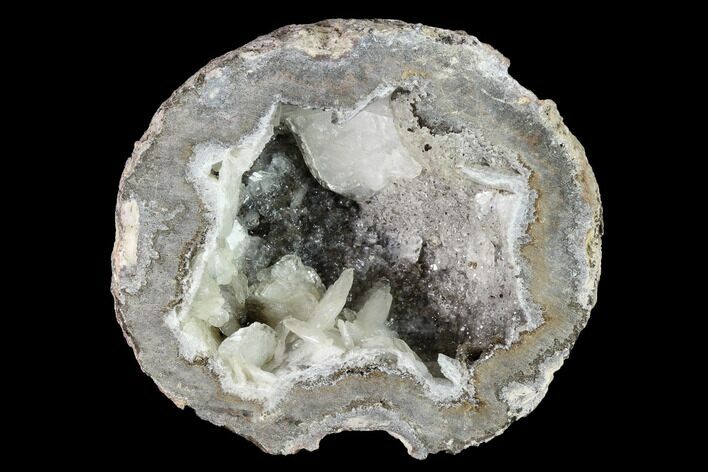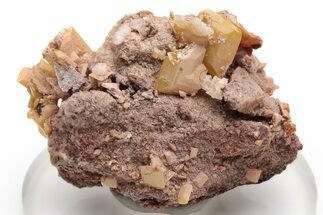This Specimen has been sold.
3.95" Las Choyas "Coconut" Geode Half with Quartz & Calcite - Mexico
This is a beautiful "coconut geode" half from Chihuahua, Mexico. It's lined with a mixture of quartz and calcite crystals. It comes with an acrylic display stand.
Geodes are rounded, hollow voids in rocks filled with crystals and other minerals. They typically form when air bubbles inside of volcanic rock form hollow cavities. Over time, as mineral-rich water seeps into the rock, those minerals deposit tiny crystals on the sides those hollow cavities. After millions of years, the flow of water gradually builds crystals inside the empty space.
Las Choyas geodes, often referred to as coconut geodes, are mined from 100 to 200 feet below the surface near Chihuahua, Mexico. Shafts are drilled down to the geode-bearing white clay, and then tunnels are dug horizontally to extract the geodes.
The geodes typically range from about 2-6 inches in diameter and can contain a variety of minerals and crystals. Most hollow geodes contain a variety of quartz, ranging from clear quartz to smoky quartz to rarer amethyst. Many secondary minerals, such as goethite, hematite, mordenite, calcite and galena, may also be present in some geodes.
Las Choyas geodes, often referred to as coconut geodes, are mined from 100 to 200 feet below the surface near Chihuahua, Mexico. Shafts are drilled down to the geode-bearing white clay, and then tunnels are dug horizontally to extract the geodes.
The geodes typically range from about 2-6 inches in diameter and can contain a variety of minerals and crystals. Most hollow geodes contain a variety of quartz, ranging from clear quartz to smoky quartz to rarer amethyst. Many secondary minerals, such as goethite, hematite, mordenite, calcite and galena, may also be present in some geodes.
About Quartz
Quartz is the name given to silicon dioxide (SiO2) and is the second most abundant mineral in the Earth's crust. Quartz crystals generally grow in silica-rich environments--usually igneous rocks or hydrothermal environments like geothermal waters--at temperatures between 100°C and 450°C, and usually under very high pressure. In either case, crystals will precipitate as temperatures cool, just as ice gradually forms when water freezes. Quartz veins are formed when open fissures are filled with hot water during the closing stages of mountain formation: these veins can be hundreds of millions of years old.
Quartz is the name given to silicon dioxide (SiO2) and is the second most abundant mineral in the Earth's crust. Quartz crystals generally grow in silica-rich environments--usually igneous rocks or hydrothermal environments like geothermal waters--at temperatures between 100°C and 450°C, and usually under very high pressure. In either case, crystals will precipitate as temperatures cool, just as ice gradually forms when water freezes. Quartz veins are formed when open fissures are filled with hot water during the closing stages of mountain formation: these veins can be hundreds of millions of years old.
About Calcite Crystals
Calcite crystals are a form of calcium carbonate (CaCO₃) known for their diverse shapes, transparency, and vibrant range of colors. They typically form in rhombohedral, scalenohedral, or prismatic shapes, often with well-defined, sharp edges and glossy surfaces. Calcite crystals are often translucent or transparent, sometimes displaying a double refraction effect where objects viewed through the crystal appear doubled. They can appear in various colors—white, clear, yellow, pink, blue, green, and orange—depending on impurities or trace minerals.
A notable characteristic of calcite is its reaction with weak acids like vinegar, which causes it to effervesce, or fizz, as it releases carbon dioxide. This property makes calcite crystals a key tool in geological identification and studies. Calcite forms in many environments, from sedimentary rocks like limestone and marble to hydrothermal veins.
Calcite crystals are a form of calcium carbonate (CaCO₃) known for their diverse shapes, transparency, and vibrant range of colors. They typically form in rhombohedral, scalenohedral, or prismatic shapes, often with well-defined, sharp edges and glossy surfaces. Calcite crystals are often translucent or transparent, sometimes displaying a double refraction effect where objects viewed through the crystal appear doubled. They can appear in various colors—white, clear, yellow, pink, blue, green, and orange—depending on impurities or trace minerals.
A notable characteristic of calcite is its reaction with weak acids like vinegar, which causes it to effervesce, or fizz, as it releases carbon dioxide. This property makes calcite crystals a key tool in geological identification and studies. Calcite forms in many environments, from sedimentary rocks like limestone and marble to hydrothermal veins.
SPECIES
Quartz & Calcite
LOCATION
Chihuahua, Mexico
SIZE
3.95" wide
CATEGORY
SUB CATEGORY
ITEM
#145858
 Reviews
Reviews














